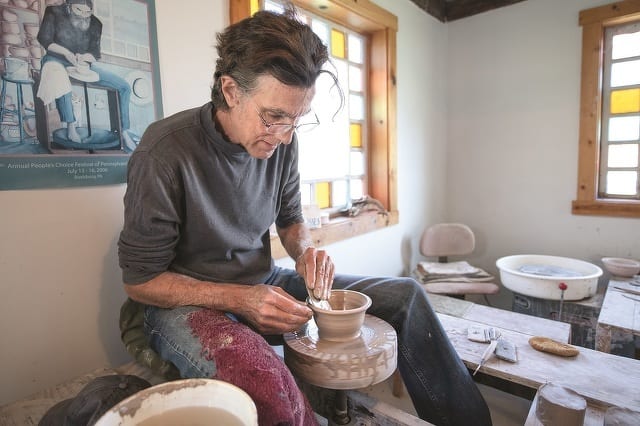You can find Scot Paterson on any given mid-morning strolling out to his self-renovated backyard workshop, finished off with reclaimed barn siding. The reflective bright blue hues of glazed mugs contrast the matte color of the untouched clay. Amongst the rustic workspace and shelves filled with pottery pieces of various shapes and sizes lies the driving force behind Paterson’s business: his hands at the wheel.
Paterson, owner and founder of Aaronsburg Pottery, has a meticulous creation process that begins each morning with a pile of clay and an appreciation for his customer. Based on experience, Paterson can estimate how much clay will garner the desired amount of pieces he needs just by looking at it. The clay is then formed at the wheel, hand-signed on the bottom, and placed into the kiln for its first firing. Each piece is fired twice and glazed individually by hand.Paterson finds each stage of the creation process an art form in and of itself.
“Turning that lump of clay into its very first form is an amazing feeling,” he says. “The glazing works another part of the brain, because you have to imagine how the piece is going to look once it comes out of the kiln; where the piece sits in the kiln directly affects how it will look.”
With such a personalized creation process comes a loyal customer base. Paterson explains that most of his new ideas derive from people who have one of everything he has made, and want more.
“My customer base keeps me aware of what I am selling and what more I need to have. It’s a big part that drives my creativity; it also creates great relationships,” explains Paterson.
Unlike wholesale potters, whose clients can expect the exact same shape and feel to each and every piece from the use of a caliper, Paterson handcrafts each piece, creating a related, but not identical, feel.
“A lot of people come in and try pottery, to see how it fits in their hand; that’s part of the connection,” says Paterson.
For customers looking for a piece that doesn’t live on the shelves, Paterson works directly with them to create what they have in mind.
The firing and glazing process can never create the same item twice, so when asked by customers if he can make four or six more of something, he responds with, “Well, maybe,” and a chuckle.
Paterson says he is committed to making pieces work for his clients, and finds that even if the glaze or shape turns out slightly different than anticipated, they appreciate that aspect of his art.
In addition to his backyard workspace, Paterson splits his time at his Aaronsburg gallery. The gallery has been a Centre County staple for 27 years now, and is a way for Paterson to bring his pottery to clients, rather than carting it around from show to show.

Photo by Darren Andrew Weimert
One of his favorite aspects of the gallery is watching people attach to a particular piece. Paterson still has a hard time predicting exactly what the customer will go for.
“I might put a piece on the shelf and think it will leave right away, and it doesn’t. The same goes for pieces I thought would sit for a while; they are the first to leave,” he says with amusement.
Paterson’s business has expanded past the four walls of his historic log-home gallery and made its way online to Facebook, Instagram, and the small business-favored website, Etsy.
Paterson has been grateful and is shocked by the reach of his artwork through Etsy.
“Most of my orders on Etsy are from around the country, from people who haven’t seen my pottery or held it in hand before,” he says. “I’ve sent pottery out to New Jersey, Georgia, Minnesota, California. I’ve even sent some pottery up to Alaska.”
While Paterson is flattered by the online exposure, the People’s Choice Festival in Boalsburg that typically takes place in July remains a huge event for him to meet new people.
“Typically, I would get a lot of exposure at the People’s Choice Festival, because I would meet a lot of local people from the region,” says Paterson.
Like many other small-business owners and artisans in Centre County, Paterson has felt the impacts of canceled events and local restrictions, all while navigating what his new business operation looks like during the pandemic.
With such a client connection-based business, Paterson remains optimistic and thankful as he looks ahead.
“Returning customers are a huge part of my business; it’s keeping me going,” he says, adding, “next year will certainly be a different year. I am optimistic that things will be getting better.”
Elizabeth Molek is a freelance writer.



